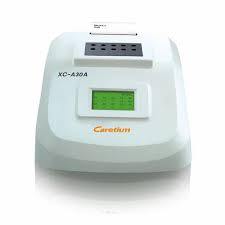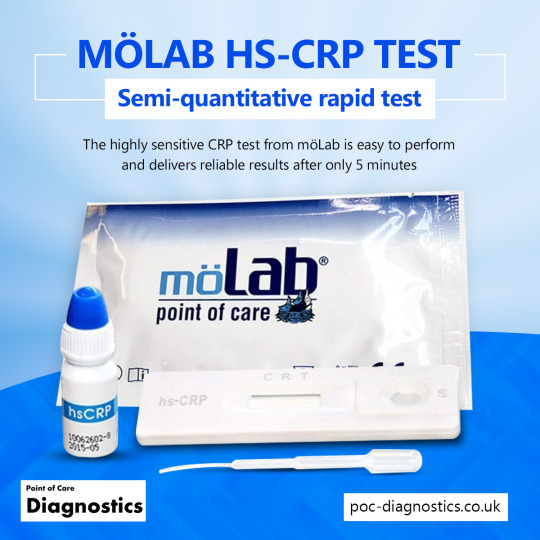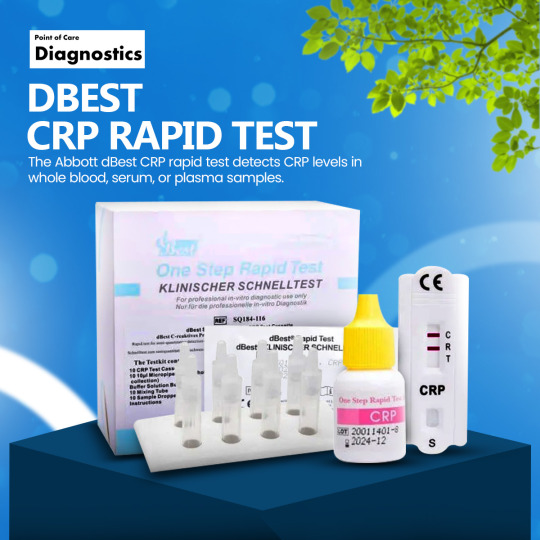#InflammationTest
Explore tagged Tumblr posts
Text

Fast, Reliable & Accurate – CRP Testing Made Easy!
Need quick inflammation or infection detection? The Servoprax Clear Test CRP 10/40/80 Rapid Test delivers results in just 5 minutes!
✅ Detects C-reactive protein (CRP) levels in just 5 minutes
✅ Three clear result lines: 10, 40, 80 mg/L
✅ Ideal for inflammation & infection assessment
✅ Small sample volume needed, includes 10 µl capillaries
✅ Easy storage (2 - 30°C) & user-friendly
Speed up your diagnostics with POC Diagnostics! Learn more: https://poc-diagnostics.co.uk/products/servoprax-clear-test-crp-10-40-80-rapid-test
#CRPRapidTest#POCDiagnostics#MedicalTesting#InflammationTest#PointOfCare#RapidDiagnostics#QuickResults#CRPLevels#HealthcareInnovation#MedicalDevices#FastTesting#InfectionDetection#POCTest#LabTesting#HealthTech#MedicalSupplies
0 notes
Text
ESR Analyzer Market overview highlighting current trends and growth opportunities

The ESR Analyzer Market is evolving rapidly, with growing global attention on early disease detection and efficient diagnostic solutions fueling this change.
Introduction
The ESR (Erythrocyte Sedimentation Rate) Analyzer is a diagnostic device used to detect inflammation linked to conditions such as infections, autoimmune diseases, and cancers. As healthcare systems across the globe focus more on accurate and early diagnosis, ESR analyzers have gained significant relevance. This blog explores the current state of the ESR Analyzer Market, including prominent trends and potential growth areas.
Market Size and Current Scenario
The ESR Analyzer Market has shown steady growth over the past decade. The rise in global disease burden, especially chronic and autoimmune diseases, has driven the adoption of diagnostic technologies. Hospitals, diagnostic labs, and research institutions are increasingly using ESR analyzers to streamline testing processes and improve diagnostic accuracy.
According to industry insights, North America currently leads the ESR analyzer demand, closely followed by Europe and Asia-Pacific. This growth is attributed to the well-established healthcare infrastructure in developed regions and the rising healthcare investment in emerging economies.
Key Market Trends
1. Automation and Compact Devices
One of the most visible trends is the shift toward automation. Modern ESR analyzers offer fully automated processes with higher accuracy, reducing human error and increasing lab efficiency. Manufacturers are also introducing compact models suitable for smaller laboratories and clinics.
2. Integration with Laboratory Information Systems (LIS)
Another significant advancement is the integration of ESR analyzers with LIS. This connectivity allows seamless data sharing, faster report generation, and improved patient data management, especially beneficial for large hospitals and diagnostics chains.
3. Increased Testing Volumes
The COVID-19 pandemic led to an increased awareness of inflammation markers. While ESR is not specific to COVID-19, the focus on inflammatory markers has indirectly boosted the usage of ESR analyzers in many healthcare setups. This trend is continuing as part of routine check-ups and chronic disease monitoring.
Growth Opportunities
1. Rising Healthcare Access in Emerging Economies
Countries in Asia, Africa, and Latin America are expanding healthcare access. Governments are investing in public healthcare facilities and diagnostic services. These regions present vast opportunities for ESR analyzer manufacturers to introduce cost-effective models tailored to budget-conscious buyers.
2. Product Customization for Diverse Needs
As the diagnostic market becomes more diverse, there is a growing need for analyzers with different capabilities. Portable models for remote clinics, advanced machines for tertiary care hospitals, and mid-range analyzers for city diagnostics labs are being developed. This customization opens new revenue streams for manufacturers.
3. Chronic Disease Surveillance Programs
Government-led surveillance programs for diseases like tuberculosis, diabetes, and rheumatoid arthritis often include ESR tests. Expansion of such programs increases the demand for reliable and efficient analyzers.
Regional Highlights
North America:
High adoption rates of advanced diagnostics and presence of leading manufacturers. Strong demand for automation and LIS-compatible devices.
Europe:
Focus on research and development. Preference for precision and regulatory-compliant equipment.
Asia-Pacific:
Fastest-growing market due to population size, government initiatives in healthcare, and rising health awareness.
Middle East & Africa:
Gradual growth supported by healthcare reforms and international collaborations in diagnostics.
Challenges in the Market
Despite promising growth, certain challenges remain:
High Cost of Advanced Devices: Small and rural labs may find modern ESR analyzers too expensive.
Limited Technical Skills: In some developing regions, lab staff may lack training in using advanced diagnostic equipment.
Maintenance Issues: Regular calibration and servicing are crucial for accuracy. Lack of service support in remote areas can limit long-term usability.
Addressing these challenges through training programs, affordable pricing models, and after-sales services will be key to sustained growth.
Strategic Moves by Market Players
Major manufacturers are focusing on:
Partnerships with local distributors to expand market reach.
Launching mid-range products to balance cost and performance.
Investing in R&D to enhance automation and accuracy.
Expanding their presence in untapped markets through joint ventures or licensing deals.
These strategies are shaping a more competitive yet opportunity-rich market.
Conclusion
The ESR Analyzer Market is positioned for strong growth, driven by technological progress, rising healthcare awareness, and expanding diagnostics infrastructure worldwide. While challenges like affordability and technical support persist, proactive strategies by manufacturers and stakeholders are expected to bridge these gaps.
As more countries prioritize early disease detection and chronic condition management, ESR analyzers will play a vital role in diagnostic labs across the globe. The key to future success lies in offering value-driven, efficient, and accessible products.
#ESRAnalyzerMarket#DiagnosticDevices#ClinicalLaboratories#MedicalTechnology#InflammationTesting#HealthcareGrowth#LabAutomation#ChronicDiseaseDiagnosis#MedicalDevices#GlobalHealth#HealthcareTrends#ESRTesting#MedicalDiagnostics#AsiaHealthcare#DiagnosticMarketGrowth#HospitalEquipment#MedicalResearch#HealthcareInnovation#LabEquipment#EmergingMarkets
0 notes
Text
ESR Analyzer Market Trends Shaping Diagnostic Innovation in Global Healthcare Testing Systems

The ESR Analyzer Market is entering a transformative phase, fueled by a growing demand for accurate and timely diagnostics in modern healthcare. As global health systems evolve, ESR (Erythrocyte Sedimentation Rate) testing is gaining renewed attention for its critical role in identifying inflammation and chronic illnesses. Alongside the need for faster diagnoses and streamlined workflows, innovations in ESR analyzer technology are shaping the future of diagnostic testing across hospitals, clinics, and laboratories.
Understanding ESR Analyzers
An ESR analyzer is a clinical device used to measure the rate at which red blood cells settle in a period of one hour. This test is commonly used to detect inflammation in the body, which could be a result of infections, autoimmune diseases, or chronic conditions. Because of its simplicity and diagnostic relevance, the ESR test remains a staple in routine health screenings and disease monitoring.
Key Trends Driving the ESR Analyzer Market
• Rising Demand for Automation: Healthcare facilities are rapidly adopting automated ESR analyzers to enhance laboratory efficiency. Automation reduces the possibility of human error, improves sample throughput, and allows labs to handle higher test volumes without compromising on accuracy.
• Point-of-Care Testing (POCT) Expansion: Portable and user-friendly ESR analyzers are becoming more prevalent, especially in decentralized settings. From rural health centers to emergency care units, the demand for quick, on-the-spot diagnostic tools is accelerating. These compact analyzers are ideal for situations where immediate test results are critical for treatment decisions.
• Integration with Digital Healthcare Infrastructure: ESR analyzers are increasingly being integrated with Laboratory Information Management Systems (LIMS), Electronic Health Records (EHR), and hospital databases. This digital connectivity ensures seamless data transfer, centralized patient records, and reduced administrative workload.
In the ESR Analyzer Market, innovation is not just about speed—it’s about connectivity, precision, and reliability in patient diagnosis.
Impact of Chronic Disease Prevalence
The global rise in autoimmune and inflammatory diseases is a major driver behind the increasing adoption of ESR analyzers. Conditions such as arthritis, lupus, and vasculitis are on the rise, and ESR tests play a vital role in both diagnosis and long-term monitoring. Healthcare providers are now prioritizing tools that offer consistent and repeatable results to improve patient care pathways.
• Aging Populations: As populations in many countries continue to age, the incidence of age-related chronic inflammation is increasing. ESR testing, being a non-invasive and affordable diagnostic approach, is seeing greater inclusion in geriatric care protocols.
• Preventive Healthcare Focus: Governments and private health institutions are pushing for more preventive diagnostic programs. ESR testing is being incorporated into annual health checks and screening packages, enhancing its market potential further.
Technological Innovations Reshaping the Market
• AI and Machine Learning Integration: Next-generation ESR analyzers are beginning to leverage AI-based algorithms to identify abnormal patterns and flag critical results faster. Machine learning also helps in predicting trends over time by analyzing past data, enabling more proactive healthcare delivery.
• Improved User Interfaces and Touchscreen Displays: Modern ESR analyzers are being designed with user-centric interfaces to minimize training time and improve operational efficiency. Touchscreens, guided workflows, and visual result interpretation are making these devices easier to operate for both technicians and clinicians.
• Sustainable and Low-Maintenance Designs: Manufacturers are also innovating with eco-friendly materials and maintenance-free components, which is particularly appealing to smaller clinics and facilities with limited resources.
Regional Growth Patterns
The ESR analyzer market is expanding at different rates across various global regions. Developed countries are seeing a shift towards high-end, automated models with advanced connectivity features. In contrast, emerging markets are focusing on cost-effective and portable options that can support community-level healthcare.
• Urban vs Rural Deployments: While urban hospitals are leading in technology adoption, rural areas are becoming key markets for simplified ESR analyzers that don’t require intensive training or infrastructure. This dual-market trend is encouraging manufacturers to offer a broad spectrum of product models.
Future Outlook
The ESR analyzer market is well-positioned for steady growth in the coming years. With a heightened global focus on healthcare modernization, investments in diagnostics are expected to rise. Governments, health institutions, and private players are recognizing the importance of quick, accurate, and scalable testing solutions.
As diagnostic standards evolve, the ESR analyzer will continue to play a foundational role in both routine care and specialized disease monitoring. Technological innovation, coupled with an expanding healthcare footprint worldwide, will ensure the ESR Analyzer Market remains a dynamic and essential segment in the broader medical diagnostics industry.
#ESRAnalyzerMarket#HealthcareDiagnostics#MedicalInnovation#PointOfCareTesting#AutomationInHealthcare#InflammationTesting#ChronicDiseaseCare#GlobalHealthTech#DigitalDiagnostics#PortableMedicalDevices
0 notes
Text

When precision is key, the möLab hs-CRP Test delivers.
This high-sensitivity test provides accurate C-reactive protein (CRP) results in minutes, helping healthcare professionals detect and monitor low levels of inflammation with confidence.
Ideal for early detection and management of cardiovascular risks, the möLab hs-CRP Test combines advanced technology with ease of use. It’s a trusted solution for better patient care, right at the point of need.
Transform your diagnostic capabilities with the möLab hs-CRP Test.
Learn more at https://poc-diagnostics.co.uk/products/molab-hs-crp-test
0 notes
Text

Quick and accurate results matter when assessing inflammation. The dBest CRP Rapid Test provides reliable C-reactive protein (CRP) levels in minutes, supporting better clinical decisions right at the point of care.
With its user-friendly design and precision performance, this rapid test is a valuable tool for diagnosing and monitoring infections, inflammation, and other critical conditions. It’s healthcare simplified, without compromising accuracy.
Empower your practice with a solution that prioritizes speed, accuracy, and patient outcomes.
Discover the dBest CRP Rapid Test at: https://poc-diagnostics.co.uk/products/dbest-crp-rapid-test
1 note
·
View note